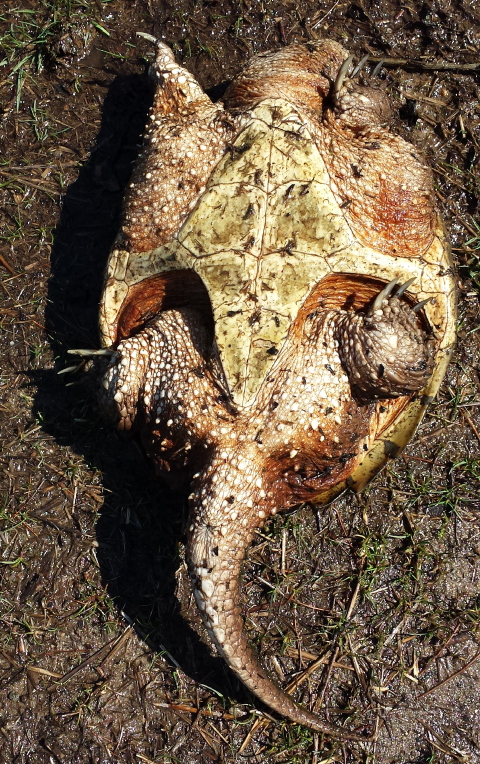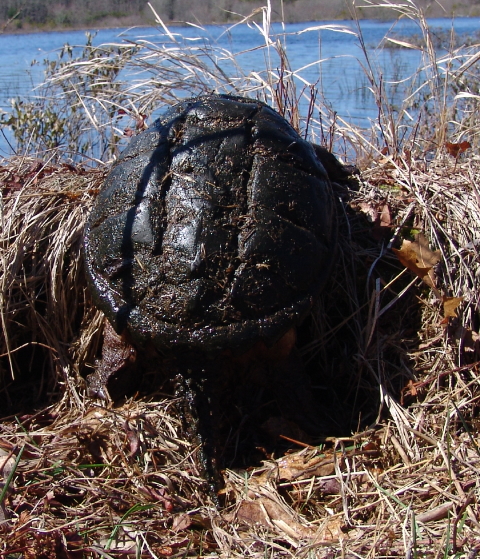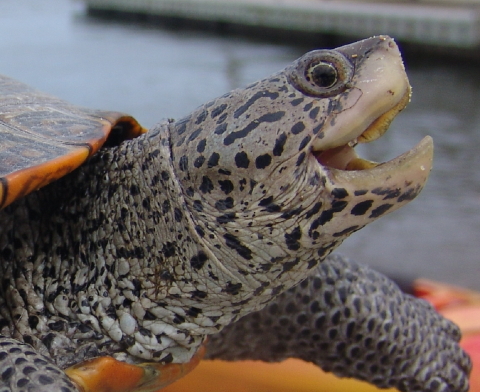Snapping Turtle (Chelydra serpentina)
Temperatures on the SouthCoast dropped more than 30 degrees, and morning broke with fierce north winds pelting the ground with sleet and snow. Â Not particularly favorable conditions for finding cold-blooded reptiles. Â Fortunately, though, massive snappers retain enough heat to weather these cold snaps while maintaining minimal activity levels. Â Most aquatic turtles burrow back into the ooze, cover themselves with an extra layer of mud and resume a restful slumber until the situation improves.
Snapping Turtle Netted on Chilly SouthCoast Morning
With those conditions in mind, the Turtle Journal team drove to a local wetlands this morning where we hoped to find a snapper on the move. Â As luck would have it, we spotted a young 12-to-15 pounder cruising the shallows just under the surface. Â We deftly snaked a net through a tangle of brambles and snared the unsuspecting snapper. Â As you can intuit from the photograph above, this snapper was simply “delighted” to meet the Turtle Journal researchers this morning and he offered a mouthful of commentary.
Snapper Chomps Down on Net Rim
As we attempted to release him from the net, the snapper expressed his displeasure by chomping down his jaws with vise grip force and refused to let go. Â If you have any doubt about the power of a snapper’s jaws, disabuse such thoughts.
Snapping Turtle Plastron (Bottom Shell)
Snapping turtles are ferocious critters. Â They have long necks and use them liberally to snap at anything and anybody who poses a threat. Â If you examine a snapper’s bottom, you will note that the plastron (bottom shell) is quite inadequate to protect all of the turtle’s tender spots. Â So, it is unsurprising that snappers employ a fierce and aggressive attitude to ensure their survival. Â And they are very, very practiced at showy aggression. Â In reality, though, they would prefer to avoid an actual confrontation unless cornered. Â Should you approach one while snorkeling, the snapper will usually swim away and disappear into the murk. Â But I would caution you against pressing a snapper to action. Â You may find the outcome very unpleasant.
IF YOU HAVE AN iPAD & CAN’T SEE VIDEO, CLICK HERE.
Nothing Sweeter Than a Snapper’s Smile
Once we freed the snapper from the net, he immediately lunged towards us and flashed a broad, throaty grin. Â As any herpetologist knows, a snapper’s smile will melt your heart or rip off your face. Â It’s all the same to the snapper who personifies tough love.
Snapping Turtle Carapace (Top Shell)
Having registered his objections to our scientific examination, the snapper determinedly trod back towards the safety of its wetlands.
Snapping Turtle’s Impressive Nails
A log blocked his pathway. Â The snapper used his large, powerful claws to grip the obstacle and propel himself over the log and back into the pond.
Snapping Turtle’s Impressive “Prehistoric” Tail
As the snapper thrust himself into the murky wetlands, he displayed his rather impressive “dinosaur” tail. Â If we had any doubt that turtles have been on Earth for a long, long time … approaching 300,000,000 years, snappers reteach that valuable lesson with each encounter.























